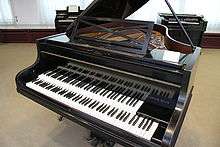Emánuel Moór


Emánuel Moór (19 February 1863 – 20 October 1931) was a Hungarian composer, pianist, and inventor of musical instruments.
Moór was born in Kecskemét, Hungary, and studied in Prague, Vienna and Budapest. Between 1885 and 1897 he toured Europe as a soloist and ventured as far afield as the United States. Besides five operas and eight symphonies his output also included: concertos for piano (4), violin (4), cello (2), viola, and harp; a triple concerto for violin, cello, and piano; chamber music; a requiem; and numerous lieder. He died, aged 68, in Chardonne, Switzerland.
His best-known invention was the Emánuel Moór Pianoforte,[1] which consisted of two keyboards lying one above each other and allowed, by means of a tracking device, one hand to play a spread of two octaves.[2] The double keyboard pianoforte was promoted extensively in concerts throughout Europe and the United States by Moór's second wife, the British pianist Winifred Christie.
Maurice Ravel said that the Emánuel Moór Pianoforte produced the sounds he had really intended in some of his works, if only it had been possible to write them for two hands playing on a standard piano.[3] Pablo Casals always believed in him and often played his works.
Moór and Christie also collaborated on a book of technical exercises for the instrument.
Notes
- ↑ Sometimes referred to as the Duplex-Coupler Grand Pianoforte, but this name was not one that Moór himself ever used.
- ↑ The Bechstein-Moor Viola at the Wayback Machine (archived October 27, 2009) at uk.geocities.com
- ↑ Grove's Dictionary of Music and Musicians, 5th ed., 1954, Eric Blom ed.
External links
- Biography and list of works (German)
- An article from the New York Times about the Duplex-Coupler Grand Pianoforte
- Emanuel und Henrik Moór foundation (German)
- Free scores by Emánuel Moór at the International Music Score Library Project
- Audio recording of Moór playing a "Hungarian Melody", recorded 1889 (Thomas Edison National Historical Park)